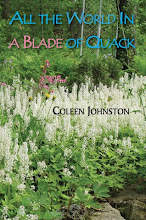
Last Day of August
It takes guts to go to the garden
in the autumn when day lilies sprawl,
when orange rose hips harden
and hollyhocks brown,
when crab grass covers it all.
Cleomes tower above me
crowding out those who are weak,
scratching with glee,
tall as young trees,
they challenge this gardener meek.
I dread the Siberian iris,
where mice are now making their nests,
no pastoral bliss
has a chance to exist--
more likely is cardiac arrest.
Defending their hive, wasps
get annoyed at my lightest footfall,
they chase me and dive
while I run for the house
like Favre carrying the football.
Yet I screw up my courage each day
and off to the garden I go
for fall's on its way
and soon housebound I'll be--
wanting danger so much more than snow.








